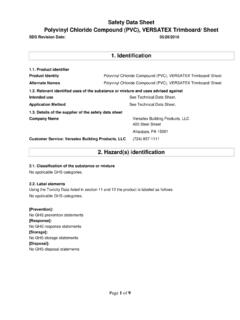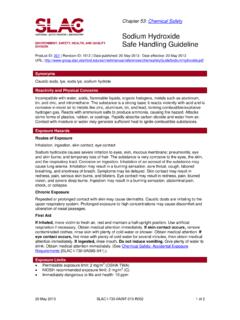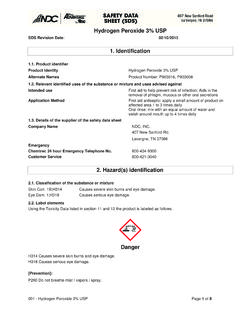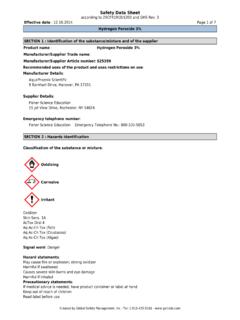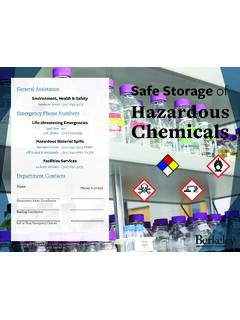Transcription of Process Safety Management for Storage Facilities
1 OSHA 3909-03 2017 Process Safety Management for Storage FacilitiesOccupational Safety and Health Act of 1970 To assure safe and healthful working conditions for working men and women; by authorizing enforcement of the standards developed under the Act; by assisting and encouraging the States in their efforts to assure safe and healthful working conditions; by providing for research, information, education, and training in the field of occupational Safety and health. This guidance document is not a standard or regulation, and it creates no new legal obligations.
2 It contains recommendations as well as descriptions of mandatory Safety and health standards. The recommendations are advisory in nature, informational in content, and are intended to assist employers in providing a safe and healthful workplace. The Occupational Safety and Health Act requires employers to comply with Safety and health standards and regulations promulgated by OSHA or by a state with an OSHA approved state plan. In addition, the Act s General Duty Clause, Section 5(a)(1), requires employers to provide their employees with a workplace free from recognized hazards likely to cause death or serious physical contained in this publication is in the public domain and may be reproduced, fully or partially, without permission.
3 Source credit is requested but not information will be made available to sensory impaired individuals upon request. Voice phone: (202) 693 1999; teletypewriter (TTY) number: 1 877 889 5627. Process Safety Management for Storage Department of LaborOccupational Safety and Health AdministrationOSHA 3909 03 2017 ContentsPurpose ..1 Applicability ..4 Employee Participation ..6 Process Safety Information ..6 Information on Highly Hazardous Chemicals ..7 Information on Process Technology ..7 Information on the Process Equipment ..8 Process Hazard Analysis (PHA).
4 9 Operating Procedures ..11 Training ..12 Mechanical Integrity ..13 Emergency Planning and Response ..15 APPENDIX: Misconceptions and Frequently Asked Questions ..17 Workers Rights ..21 OSHA Assistance, Services and Programs ..21 Establishing a Safety and Health Program ..21 Compliance Assistance Specialists ..21 Free On site Safety and Health Consultation Services for Small Business.. 21 Cooperative Programs ..22 Occupational Safety and Health Training Courses ..23 OSHA Educational Materials ..23 OSHA Regional Offices ..24 How to Contact OSHA.
5 27 Process Safety Management FOR Storage FACILITIES1 PurposeThis document does not cover the entire Process Safety Management (PSM) standard, but only focuses on aspects of the standard particularly relevant to Storage Facilities . For a full compliance guide to PSM, please refer to OSHA 31321 or the full text of the standard at Although all elements of the PSM standard apply to a PSM covered Storage facility, the following elements of the standard are most relevant to hazards associated with Storage Facilities : Employee Participation Process Safety Information (PSI) Process Hazard Analysis Operating Procedures Training Mechanical Integrity (MI) Emergency Planning and ResponsePSM is critically important to Facilities that store highly hazardous chemicals.
6 Implementing the required Safety programs help prevent fires, explosions, large chemical spills, toxic gas releases, runaway chemical reactions, and other major incidents. This will ensure that employees, contractors, facility visitors and emergency responders are safe from these hazards. Compliance will also benefit employers by minimizing damage to facility equipment and neighboring structures in the event of an HHC release. Between 1997 and 2013, there have been numerous incidents at Storage Facilities that have caused serious injuries and fatalities to employees.
7 Several examples are included below: In 2013, a facility that stored and distributed compressed propane gas was largely destroyed by a series of fires and explosions. After receiving spent propane gas cylinders, employees would bleed any remaining gas into the air 1. Safety AND HEALTH ADMINISTRATION2before the cylinders were cleaned and reused. On the night of the incident, investigators believe, this practice resulted in a cloud of flammable propane gas at the facility, which was ignited by a spark from a forklift operating in the area. The resulting explosions and fires injured several employees four critically.
8 In 2008, a nearly 90 year old Storage tank catastrophically failed and released approximately million gallons of liquid fertilizer. The collapsing tank seriously injured two employees, and the chemicals flowed over containment berms. Investigators determined that defective welds likely caused the tank failure, and inspectors condemned another tank at the same facility that presented an imminent danger of failure. Major contributing factors were the inadequacy of tank weld inspections and overestimates of the maximum liquid levels that the tank could safely accommodate.
9 Further, some tank inspection and testing activities did not follow recognized and generally accepted good engineering practices. This is a recurring category of incident: between 1995 and 2008, 16 tanks at other Facilities catastrophically failed, killing one employee and hospitalizing four others. Faulty welding caused 11 of these tank failures (CSB, 2009). In 2005, a fire and subsequent explosion(s) destroyed a facility that stored and distributed compressed gas, and propelled debris and projectiles. The incident was traced back to propylene gas cylinders in the facility s Storage area that were directly exposed to sunlight.
10 High temperatures from the sunlight exposure increased cylinder pressure enough to cause flammable vapors to leak from the cylinders and catch fire. Heat from the initial fire caused other cylinders to leak gas. The fire spread throughout the Storage area and eventually consumed nearly 8,000 cylinders of compressed gas. In 2003, an industrial facility that stores and distributes chlorine received a routine railcar shipment of liquid chlorine. The chlorine was transferred to a bulk trailer, a procedure that the facility had conducted for many Process Safety Management FOR Storage FACILITIES3years without serious incident.













